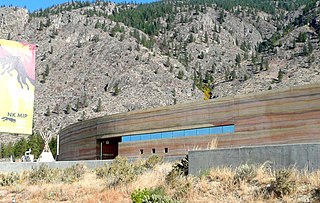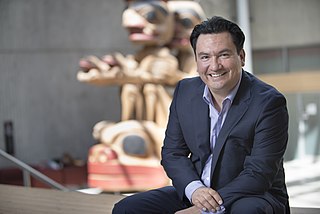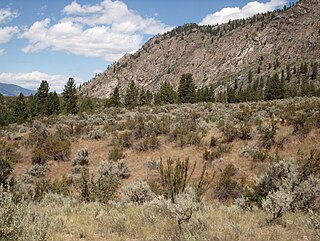In Canada, an Indian reserve is defined by the Indian Act as a "tract of land, the legal title to which is vested in His Majesty, that has been set apart by His Majesty for the use and benefit of a band." Reserves are areas set aside for First Nations, one of the major groupings of Indigenous peoples in Canada, after a contract with the Canadian state, and are not to be confused with indigenous peoples' claims to ancestral lands under Aboriginal title.

The Okanagan, also called the Okanagan Valley and sometimes the Okanagan Country, is a region in the Canadian province of British Columbia defined by the basin of Okanagan Lake and the Canadian portion of the Okanagan River. It is part of the Okanagan Country, extending into the United States as Okanogan County in north-central Washington. According to the 2016 Canadian census, the region's population is 362,258. The largest populated cities are Kelowna, Penticton, Vernon, and West Kelowna.

Osoyoos is the southernmost town in the Okanagan Valley in British Columbia between Penticton and Omak. The town is 3.6 km (2.2 mi) north of the United States border with Washington state and is adjacent to the Osoyoos Indian reserve. The origin of the name Osoyoos was the word sw̓iw̓s meaning "narrowing of the waters" in the local Okanagan language (Syilx'tsn). The "O-" prefix is not indigenous in origin and was attached by settler-promoters wanting to harmonize the name with other place names beginning with O in the Okanagan region. There is one local newspaper, the Osoyoos Times.

Oliver is a town near the south end of the Okanagan Valley in the Southern Interior of British Columbia, Canada, with a population of nearly 5,000 people. It is located along the Okanagan River by Tuc-el-nuit Lake between Osoyoos and Okanagan Falls, and is labelled as the Wine Capital of Canada by Tourism British Columbia. It was once "The Home of the Cantaloupe" as well as the "Home of the International Horseshow."
Jeannette Christine Armstrong is a Canadian author, educator, artist, and activist. She was born and grew up on the Penticton Indian reserve in British Columbia's Okanagan Valley, and fluently speaks both the Syilx and English languages. Armstrong has lived on the Penticton Native Reserve for most of her life and has raised her two children there. In 2013, she was appointed Canada Research Chair in Okanagan Indigenous Knowledge and Philosophy.
School District 53 Okanagan Similkameen is a school district that serves fragments of the southern Okanagan and lower Similkameen regions, which include Cawston, Hedley, Keremeos, Okanagan Falls, Oliver, and Osoyoos, totaling to six communities in the district, all of which are in British Columbia, Canada. Its main "maintenance department" office is held in Oliver, consisting of ten schools, five of which are elementary, three are high or secondary schools, while two are alternative schools. This district's superintendent is Beverly Young, while 2,665 students attend schools in it; there are 480 employees for the Okanagan Simlkammen school district. Their motto is "Learning Today for Living Tomorrow", and all places within the district are towns or villages.
Grand Chief Stewart Phillip is an Okanagan Aboriginal leader who has served as President of the Union of BC Indian Chiefs since 1998. As Chief of the Penticton Indian Band in British Columbia from 1994 until 2008, as well as Chair of the Okanagan Nation Alliance, he has advocated for Aboriginal rights for the First Nations in that province and particularly in the Okanagan region. He was awarded the title Grand Chief by the Okanagan Nation in 2006 in honour of his lifetime of commitment to and work for Indigenous rights and title.

The Syilx people, also known as the Okanagan, Okanogan or Okinagan people, are a First Nations and Native American people whose traditional territory spans the Canada–US boundary in Washington state and British Columbia in the Okanagan Country region. They are part of the Interior Salish ethnological and linguistic grouping. The Syilx are closely related to the Spokan, Sinixt, Nez Perce, Pend Oreille, Secwepemc and Nlaka'pamux peoples of the same Northwest Plateau region.

The Westbank First Nation is a self-governing First Nations band in the Okanagan region of British Columbia, Canada, and is one of eight bands that comprise the Okanagan Nation Alliance of Syilx people. Westbank First Nation (WFN) is governed by one chief and four councillors, elected every three years by WFN membership. As of April 2019, WFN's membership totaled 914 members, and employs more than 200 people.

The Osoyoos Indian Band is a First Nations government in the Canadian province of British Columbia, located in the town of Oliver and Osoyoos in the Okanagan valley, approximately four kilometres north of the Canada–United States border. They are a member of the ×Okanagan Nation Alliance. The band controls about 32,000 acres of land in the vicinity of the town of Oliver and Osoyoos.
The Okanagan Nation Alliance is a First Nations Tribal Council in the Canadian province of British Columbia, spanning the Nicola, Okanagan and Similkameen Districts of the Canadian province of British Columbia and also the Colville Indian Reservation in Washington state of the United States of America. Their territory covers roughly 69,000 km2 in the Canadian Province of British Columbia and also some area of Washington state in the United States of America. The diverse landscape covers deserts, lakes, forests, and grasslands.
The lack of treaties between the First Nations of British Columbia (BC) and the Canadian Crown, is a long-standing problem that has become a major issue in recent years. In 1763, the British Crown declared that only it could acquire land from First Nations through treaties. Historically only two treaties were signed with the First Nations of British Columbia. The first of which was the Douglas Treaties, negotiated by Sir James Douglas with the native people of southern Vancouver Island from 1850-1854. The second treaty, Treaty 8, signed in 1899 was part of the Numbered Treaties that were signed with First Nations across the Prairie regions. British Columbian Treaty 8 signatories are located in the Peace River Country or the far North East of BC. For over nine decades no more treaties were signed with First Nations of BC; many Native people wished to negotiate treaties, but successive BC provincial governments refused until the 1990s. A major development was the 1997 decision of the Supreme Court of Canada in the Delgamuukw v. British Columbia case that Aboriginal title still exists in British Columbia and that when dealing with Crown land, the government must consult with and may have to compensate First Nations whose rights are affected.

Glooscap First Nation is a Canadian Mi'kmaq aboriginal community located in both Kings County and Hants County, Nova Scotia. Also known as Kluskap, its reserve is located approximately 6.4 kilometres (4.0 mi) from the Town of Hantsport. Created in 1907 as Horton 35, the reserve encompasses some 171.1 hectares of rolling, mainly forested land. Forest management is practiced by the band. There is a variety store, gas bar, Greco Pizza, and gaming centre. There is also a health centre, youth centre and chapel. The Glooscap Landing Business Park is also owned by Glooscap First Nation which houses a second gas bar and Tim Hortons. The 2023 population was 424 people of whom approximately 100 lived on the reserve, making Glooscap the third-smallest First Nation community in Nova Scotia after Bear River First Nation and Annapolis Valley First Nation. Glooscap's population grew by 41% in one decade between 2013 and 2023.

The Nk'Mip Desert Culture Centre is an interpretive centre in Osoyoos, British Columbia, Canada, It is owned and operated by the Osoyoos Indian Band and is approximately 3 km (2 mi) north of the Canada–United States border. It is situated within a semi-arid shrub-steppe desert environment, which is one of the most endangered ecosystems in Canada.
Sophie Mae Pierre, is a Canadian First Nations chief and administrator. She served as the Commissioner for the British Columbia Treaty Commission from 2009 to 2015.

Ian Campbell is an Indigenous Canadian politician. He is one of many hereditary chiefs, also known as head of family, and an elected councillor of the Squamish Nation. He serves as the chair of the Indigenous Partnerships Success Showcase, a business conference focused on economic reconciliation and partnerships between industry and Indigenous community. The event takes place annually in Vancouver, British Columbia. Campbell also serves on the board of MST Development Corporation (MST), a corporate entity which manages real estate properties owned by a partnership between the Musqueam Indian Band, the Squamish Nation, and the Tsleil-Waututh Nation. In 2018, he became the Vision Vancouver mayoral candidate for the 2018 Vancouver municipal election, but withdrew before the election.

South Okanagan—Similkameen National Park Reserve is a proposed national park reserve located in the Regional District of Okanagan-Similkameen of British Columbia. The goal of the park is to work with the local First Nations to protect a large patch of Okanagan dry forests and part of the northern reach of the Columbia Plateau ecoregion in Canada.

A series of vandalizations, church arsons, and suspicious fires in June and July 2021 desecrated, damaged, or destroyed 68 Christian churches in Canada. Coincident with fires, vandalism and other destructive events damaged churches in Canada and the United States, primarily in British Columbia. Of these, 25 were the results of fires of all causes. Canadian government officials, church members, and Canadian Indigenous leaders have speculated that the fires and other acts of vandalism have been reactions to the reported discovery of over 1,000 unmarked graves at Canadian Indian residential school sites in May 2021.

Robert Louie is a Canadian First Nations leader, lawyer, and business person. He is known especially for his role in negotiating the Westbank Self-Government Agreement, which granted his band control over land management, language, and culture.











